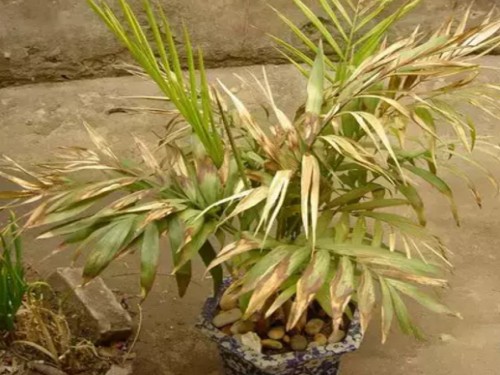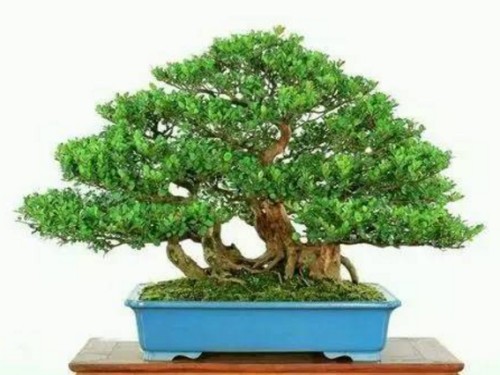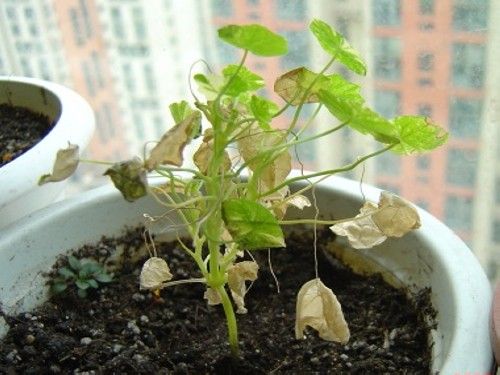What if the pocket coconut leaves turn yellow?
Pocket coconut is an evergreen small shrub, pot height generally does not exceed 1 meter, oar fruit orange, flowering in spring. Pocket coconut is a common household decoration plant, which is very popular with flower lovers, but in the process of pocket coconut breeding, the pocket coconut leaves are often yellowed, so how to do the pocket coconut leaves yellowing?

1. Air drying
Humidity is also an important element in the growth of pocket coconuts, and low humidity can cause leaves to wither.
Solution:
In order to maintain the appropriate air humidity, the air humidity must be high, and water can be sprinkled around the pot to prevent the humidity from decreasing and ensure the normal growth and development of the plant.
2. Lack of light
Pocket coconuts tend to grow in a cold environment, so putting them in places with more intense sunlight will turn the leaves yellow and lead to death.
Solution:
Daily maintenance needs to place pocket coconuts in places where the growth light is not strong, which will meet the growth needs of pocket coconuts.
3. Excessive illumination
Pocket coconuts like semi-humid and semi-overcast environment, so places with excessive light are not suitable for the growth of pocket coconuts. Strong sunlight will make pocket coconuts fade or turn yellow, losing their original bright and ornamental value.
Solution:
Pocket coconuts should be preserved in places where there is plenty of scattered light on a daily basis, which will not only benefit plant growth but also reduce health problems caused by yellowing leaves.
4. Long-term water shortage
The growth rate of pocket coconut is very fast, so its growth process needs sufficient water to supply, otherwise the lack of water, the basin soil is too dry will lead to the phenomenon of yellow leaves.
Solution:
The growth of pocket coconut needs to be accompanied by regular watering to keep the basin soil moist, so as to ensure the healthy growth and development of the plant.
5. Improper fertilization
The growth and development of pocket coconuts need to meet all the nutrients they need, so they need to be fertilized in time, but not too frequently.
Solution:
The time of fertilization can be relatively extended, and the degree of fertilization should be appropriate.
6. Diseases and insect pests
High temperatures in summer can cause pocket coconuts to be infected with diseases and insect pests, resulting in yellowing of leaves and, in severe cases, withering and death of plants.
Solution:
During the growth of pocket coconuts, attention should be paid to maintaining the ventilation of the environment and the permeability of the soil. If diseases are found and outbreaks, chlorothalonil and topiramate can be sprayed for control.
Pocket coconut, as a common green plant in family potted flowers, is currently loved by the majority of Taobao friends, but some Taobao friends reflect to Lotus that although pocket coconut is good-looking, it is not so easy to maintain. Today, Lotus will give you a detailed introduction to the daily maintenance skills of pocket coconuts.
1. Avoid bright light.
At present, it is summer, the sun is hot, as the pocket coconut is a shade-loving plant, remember not to put the pocket coconut outdoors or other places where the sun can shine directly, which will make the leaves yellow or even dry up.
2. Keep the leaves moist
In view of the situation that pruning leaves are easy to dry, Lotus recommends that you spray an appropriate amount of water on its leaves every day to ensure that pocket coconuts will not dry up due to lack of water.
3. Don't change the basin easily
As the saying goes, people move, trees move. The same is true for pocket coconuts, when cultivating pocket coconuts, you must choose a slightly larger basin, which can grow enough to save the trouble of changing pots in the future.
4. Do not accumulate water in the basin
When watering, do not let there is stagnant water in the basin, the principle of watering is: do not dry do not water, water is thoroughly.
In addition, the maintenance of pocket coconuts should also ensure indoor ventilation, do not let pocket coconuts grow in airtight rooms for a long time, so it is easy to breed diseases and insect pests. In fact, pocket coconut is a very good conservation plant, Lotus believes that as long as you Taobao friends usually use snacks, can raise pocket coconut lush!
Time: 2019-06-01 Click:
- Prev

Key points of bonsai conservation
As a kind of bonsai tree species, people are most concerned about the management and excellent potting ability after potted plants. There are more than 20 species of alpinia paniculata. The classification is mainly based on the difference of leaf shape, leaf color and leaf arrangement. The growth and habits of red Phoebe with different leaf types and leaf colors are different. For example
- Next

The causes and Solutions of the yellowing of the leaves of Trollius paniculata
Trollius, also known as Trollius, can be cultivated perennially in southern China, while in North China it is sown in autumn and cultivated indoors in pots to make it blossom during New Year's Day and Spring Festival. The leaves are fat and beautiful, and the flowers are purple, orange, creamy yellow, etc., the golden lotus vines are twisted, the leaves are shaped like a bowl of lotus, and the milky yellow flowers are in full bloom.
Related
- Fuxing push coffee new agricultural production and marketing class: lack of small-scale processing plants
- Jujube rice field leisure farm deep ploughing Yilan for five years to create a space for organic food and play
- Nongyu Farm-A trial of organic papaya for brave women with advanced technology
- Four points for attention in the prevention and control of diseases and insect pests of edible fungi
- How to add nutrient solution to Edible Fungi
- Is there any good way to control edible fungus mites?
- Open Inoculation Technology of Edible Fungi
- Is there any clever way to use fertilizer for edible fungus in winter?
- What agents are used to kill the pathogens of edible fungi in the mushroom shed?
- Rapid drying of Edible Fungi

